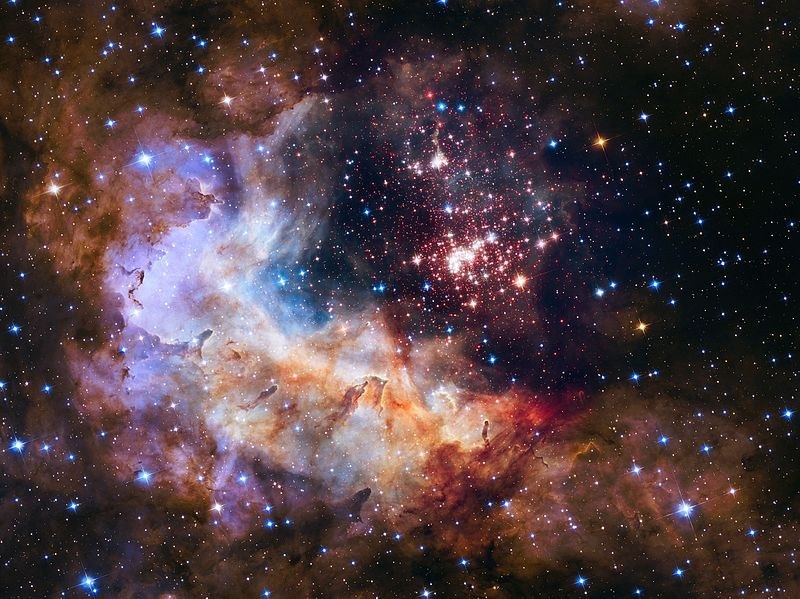 By Isabelle Robinson, M.Sc.Apr 20 2018
By Isabelle Robinson, M.Sc.Apr 20 2018Traveling at speeds of 8km/s, the Hubble telescope can complete its orbit of the Earth in 97 minutes. As it moves, the telescope can take pictures of faraway galaxies that would otherwise be unable to be seen. But how does this incredible telescope work?

Image credit: Wikimedia
Contrary to popular belief, telescopes do not rely on the magnification of objects but rather the ability to collect more light than a human eye. This means that telescopes can view far off distances with detail and clarity. The more light that reaches the telescope, the better the vision and the further it can see.
In the case of the Hubble telescope, this specialized equipment has a primary mirror and a secondary mirror. The primary mirror is only 2.4m in diameter, considerably smaller than traditional on-ground telescopes which are usually 10m or larger in width. The Hubble can see further and clearly because of its superior location above Earth’s atmosphere.
The Hubble itself is known as a Cassegrain reflector. A type of telescope which bounces light from the primary mirror to the secondary before focusing it through a small gap in the center of the primary mirror. The light can then be examined individually by the telescope’s specific scientific instruments.
Each of these instruments view the captured images in different ways as they analyze light with different frequencies.
Near-ultraviolet, visible and near-infrared light are seen using the Wide Field Camera 3. This is known to be one of the newest instruments and has a greater resolution than the other camera’s in the Hubble. In addition to this, it has a much greater field of view. Scientists believe that this camera will be used to study dark matter and the formation of stars. It is also hoped that this instrument can be used to discover galaxies that were previously beyond the Hubble’s range of sight.
The Hubble has also been newly equipped with the Cosmic Origins Spectrograph which only uses ultraviolet light. This new feature has improved the telescopes sensitivity to ultraviolet light by ten times, though this could be up to 70 times when observing extremely far and dim objects.
This is in addition to the Space Telescope Imaging Spectrograph. It uses small sources of ultraviolet, visible and near-infrared light, like distant stars or quasars, to locate black holes in space. It should be noted that in August 2004 the instrument was subject to a technical failure and had to be repaired during Servicing Mission 4, five years later.
This was also the case for the Advanced Camera for Surveys which stopped working due to an electrical short in 2007. The camera was repaired in May 2009 in the same servicing mission and can now be used to map the distribution of dark matter and search for extremely larger planets and galaxy clusters. The camera can see visible light and has been designed to study early universe activity.
The Hubble also contains the Near Infrared Camera and Multi-Object Spectrometer (also known as NICMOS) which is sensitive to infrared light. This camera is used to detect heat signatures and allows scientists to view objects that are other hidden, such as stellar birth sites which are usually obscured by interstellar dust.
The last scientific instrument contained within the Hubble is known as the Fine Guidance Sensors. This is mainly used to keep the Hubble orientated by locking onto guide stars. However, these can also be used to measure the distances between certain stars, as well as to monitor their relative motions.
The telescope has solar panels that convert the suns rays into electricity, though there are also batteries which can keep the Hubble powered when there is no sunlight available, which happens due to the Earths Shadow.
The Hubble uses four antennae to send and receive the information it collects to the Flight Operations Team which are located at the Goddard Space Flight Center in Greenbelt, Md. The telescope can be controlled by engineers by sending commands to the two main computers and numerous systems installed on the Hubble.
The team at Goddard Space Flight Center sends all the data received to the Space Telescope Science Institute who can translate it into readable information in scientific units. Astronomers around the globe can access the archived data via the internet.
This story is reprinted from material from HubbleSite, with editorial changes made by Azo Network. The original article can be found here.
Disclaimer: The views expressed here are those of the author expressed in their private capacity and do not necessarily represent the views of AZoM.com Limited T/A AZoNetwork the owner and operator of this website. This disclaimer forms part of the Terms and conditions of use of this website.